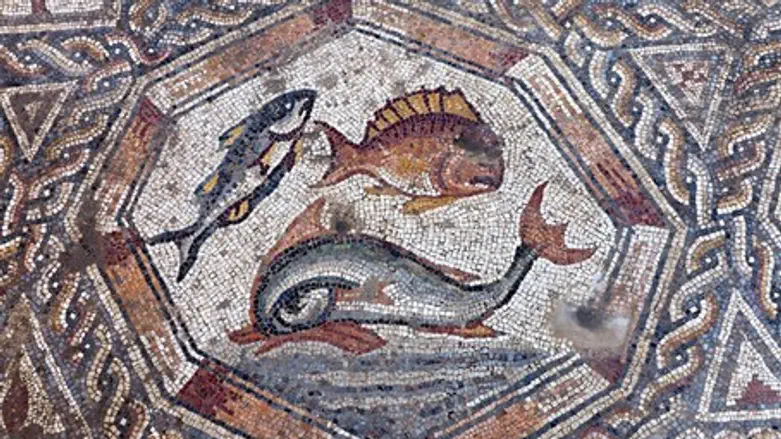
A breathtaking ancient mosaic in Lod - unearthed by the Israel Antiquities Authority (IAA) while building a visitor center for another famous mosaic - will be opened to the public for the first time this week.
The find came during an excavation from June to November 2014, when IAA archaeologists worked in the Neve Yarak neighborhood of Lod where the previously discovered mosaic was found. That earlier mosaic was the living room floor of a villa some 1,700 years ago, and is being exhibited in museums around the world.
The new excavation was meant to prepare a visitor center to house the mosaic when it returns from its tour of world museums - but during the new excavation, another colorful mosaic 11 x 13 meters in dimension was found, which served as the courtyard pavement of the same villa.
"The villa we found was part of a neighborhood of affluent houses that stood here during the Roman and Byzantine periods," explained Dr. Amir Gorzalczany, excavation director on behalf of the IAA.
"At that time Lod was called Diospolis and was the district capital, until it was replaced by Ramla after the Muslim conquest. The building was used for a very long time."
The previously discovered mosaic in the northern part of the complex, where the “Shelby White and Leon Levy Lod Mosaic Center" will be constructed, was exposed when the IAA was inspecting development work being carried out in the early 1990s prior to the construction of Highway 90.
That mosaic, which was discovered and excavated in the 1990s by the late Miriam Avissar, is among the most beautiful in the country, and has been exhibited in recent years in some of the world’s leading museums, including the Metropolitan, the Louvre and the State Hermitage. It is currently on display at the Cini Gallery in Venice, Italy, and in the future it will be housed in the main building to be erected in Lod.
As for the southern part of the complex where the new mosaic was found, it includes a large magnificent courtyard that is paved with the mosaic and surrounded by porticos (stoas - covered galleries open to the courtyard) whose ceiling was supported by columns.
“The eastern part of the complex could not be completely exposed because it extends beneath modern buildings in the neighborhood," said Gorzalczany.
Scenes in the mosaic depict hunting as well as hunted animals, fish, flowers in baskets, vases and birds. Gorzalczany noted that, "the quality of the images portrayed in the mosaic indicates a highly developed artistic ability."
Numerous fragments of frescoes (wall paintings prepared on wet plaster) reflect the decoration and the meticulous and luxurious design, which are in the best tradition of the well-born of the period. In light of the new discoveries, this part of the villa will also be incorporated in the visitor center.
Archaeologists Hagit Torgë, Uzi ‘Ad, Eriola Jakoel and Yossi Elisha of the IAA participated in the excavation.